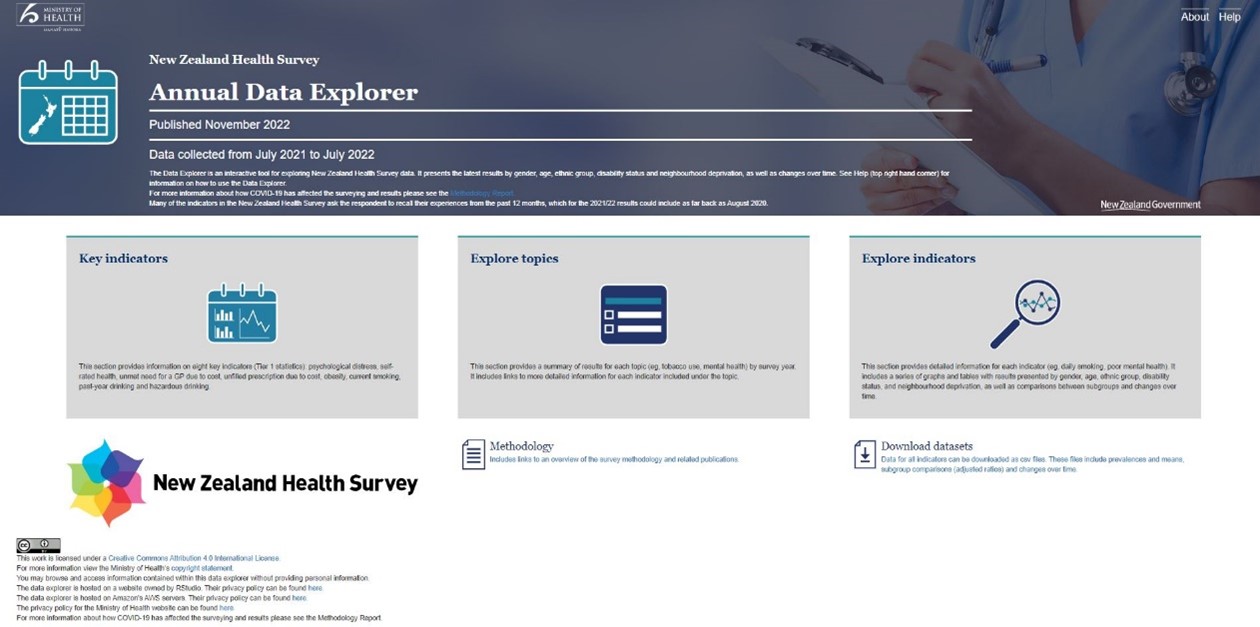The Annual Data Explorer provides a snapshot of the health of New Zealanders through the publication of key indicators on health behaviours, health status and access to health care for both adults and children.
The Annual Data Explorer shows 2016/17 results from the continuous New Zealand Health Survey, with comparisons to earlier surveys. Results are available by sex, age group, ethnic group and neighbourhood deprivation.
These statistics have been incorporated in the most recent version of the Data Explorer (updated in December 2023):
If you have any queries please email [email protected]
Overview of key findings
Health behaviours and risk factors
Current smoking
- About 600,000 adults (15.7%) were current smokers, down from 20.1% in 2006/07.
- 35% of Māori adults were current smokers, down from 42% in 2006/07.
- 24% of Pacific adults were current smokers (not a significant change from previous years – 27% in 2006/07).
- Current smoking rates are declining for younger adults, but there has been no significant change for adults aged 35 years and over since 2011/12.
- Adults living in the most socio-economically deprived areas were more than 3 times as likely to be current smokers as people living in the least deprived areas, after adjusting for age, sex and ethnic differences.
Hazardous drinking
- 1 in 5 adults (20%) drank alcohol in a way that could harm themselves or others.
- Hazardous drinking rates were higher in men (27%) than women (12%).
- Rates of hazardous drinking were highest in youth aged 18–24 years (33%).
- Despite there being more non-drinkers in the most socioeconomically deprived areas, adult drinkers in the most deprived areas were 1.7 times more likely to be hazardous drinkers than adult drinkers in the least deprived areas, after adjusting for age, sex and ethnic differences.
Obesity
- Nearly 100,000 children aged 2–14 years (12.3%) were obese. The child obesity rate has not changed significantly since 2011/12 (when it was 10.7%), although it has increased since 2006/07 (8.4%).
- 1.2 million adults (32%) were obese, up from 29% in 2011/12.
- Children living in the most socio-economically deprived neighbourhoods were 2.5 times as likely to be obese as children living in the least deprived neighbourhoods, after adjusting for age, sex and ethnic differences.
Health status
Self-rated health
- 88% of adults reported their health to be ‘good, very good or excellent’.
- 98% of parents rated their child’s health as ‘good, very good or excellent’.
Psychological distress
- 7.6% of adults experienced psychological distress in the past four weeks, up from 6.6% in 2006/07.
- Adults aged 75 years and over were the only age group for which rates of psychological distress have stayed consistently low (around 4%) since 2011/12.
- People living in the most socio-economically deprived areas were nearly three times more likely to experience psychological distress as people living in the least deprived areas, after adjusting for age, sex and ethnicity.
Access to health care
Unmet need for GPs due to cost
- 1 in 7 adults (14%) reported not visiting a GP due to cost in the past year, which is not significantly different from 2006/07.
- Only 3.0% of children did not visit a GP due to cost in the past year.
- The Ministry of Health provides additional funding to encourage free GP consultations for children under 13 years of age (the Zero Fees for Under-6s initiative started in January 2008 and was extended to Zero Fees for Under-13s in July 2015). Rates of unmet need for GP services due to cost were low for children aged 6–12 years (2.7%). This represented a decrease from the 2015/16 rate (5.8% for children aged 6–12 years).
Unfilled prescription due to cost
- About 37,000 children (3.9%) had a prescription that was not collected due to cost, down from 6.6% in 2011/12.
- About 268,000 adults (7.0%) reported not collecting a prescription due to cost in the past year.
- Māori and Pacific adults and children were more than 2 times as likely to not have collected a prescription due to cost than non-Pacific and non-Māori adults and children respectively, after adjusting for age and sex differences.
Oral health
- Most children (84%) visited a dental health care worker in the past year, up from 76% in 2006/07.
- Nearly half of adults (47%) with natural teeth visited a dental health care worker in the past year, down from 52% in 2006/07.
- At least 1 in 10 Māori and Pacific adults, and adults living in the most deprived areas had tooth extractions in the past year.
Reports from previous years
Data from previous years has been incorporated into the latest version of the data explorer. To access the reports from previous years, see our Library Catalogue.

